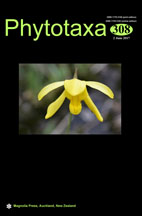Abstract
A detailed scanning electron microscopic investigation was carried out to clarify the taxonomic status of a small sigmoid Nitzschia species, a potential indicator of Central European soda waters. We found this taxon to be one of the dominant epiphytic diatoms collected from sodic bomb crater ponds at Apaj (Hungary). The large population allowed for a morphometric comparison based on frustule ultrastructure with the type material of the most similar species, Nitzschia austriaca Hustedt that was originally described from a soda pan in the region. The results clearly demonstrated an overlap between the Apaj population and the type material of N. austriaca (based on NMDS analysis), therefore we argue that they represent the same taxon. An emended diagnosis of N. austriaca is given. Total suspended solids and total phosphorous proved to be the most important factors predicting the occurrence of the species, with possible interactive effects of conductivity and pH. We then expanded the distribution of the species by revisiting data originating from previous large-scale surveys targeting sodic habitats in Hungary. On the basis of our results, N. austriaca is a characteristic species for Central European soda waters, including the protected astatic soda pans, indicating their typical chemical and physical characteristics.

